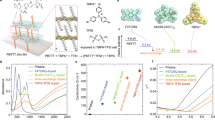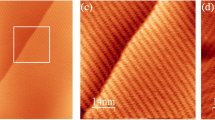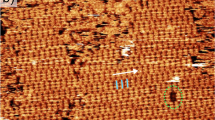Abstract
The discovery of electrically conducting organic crystals1 and polymers1,2,3,4 has widened the range of potential optoelectronic materials5,6,7,8,9, provided these exhibit sufficiently high charge carrier mobilities6,7,8,9,10 and are easy to make and process. Organic single crystals have high charge carrier mobilities but are usually impractical11, whereas polymers have good processability but low mobilities1,12. Liquid crystals exhibit mobilities approaching those of single crystals and are suitable for applications13,14,15,16,17,18, but demanding fabrication and processing methods limit their use. Here we show that the self-assembly of fluorinated tapered dendrons can drive the formation of supramolecular liquid crystals with promising optoelectronic properties from a wide range of organic materials. We find that attaching conducting organic donor or acceptor groups to the apex of the dendrons leads to supramolecular nanometre-scale columns that contain in their cores π-stacks of donors, acceptors or donor–acceptor complexes exhibiting high charge carrier mobilities. When we use functionalized dendrons and amorphous polymers carrying compatible side groups, these co-assemble so that the polymer is incorporated in the centre of the columns through donor–acceptor interactions and exhibits enhanced charge carrier mobilities. We anticipate that this simple and versatile strategy for producing conductive π-stacks of aromatic groups, surrounded by helical dendrons, will lead to a new class of supramolecular materials suitable for electronic and optoelectronic applications.
This is a preview of subscription content, access via your institution
Access options
Subscribe to this journal
Receive 51 print issues and online access
$199.00 per year
only $3.90 per issue
Buy this article
- Purchase on Springer Link
- Instant access to full article PDF
Prices may be subject to local taxes which are calculated during checkout





Similar content being viewed by others
References
Pope, M. & Swenberg, C. E. Electronic Processes in Organic Crystals and Polymers (Oxford Univ. Press, Oxford, 1999)
Shirakawa, H. The discovery of polyacetylene film: the dawning of an era of conducting polymers. Angew. Chem. Int. Edn 40, 2574–2580 (2001)
MacDiarmid, A. G. Synthetic metals: a novel role for organic polymers. Angew. Chem. Int. Edn 40, 2581–2590 (2001)
Heeger, A. J. Semiconducting and metallic polymers: the fourth generation of polymeric materials. Angew. Chem. Int. Edn 40, 2591–2611 (2001)
Sirringhaus, H., Tessler, N. & Friend, R. H. Integrated optoelectronic devices based on conjugated polymers. Science 280, 1741–1744 (1998)
Sirringhaus, H. et al. Two-dimensional charge transport in self-organized, high-mobility conjugated polymers. Nature 401, 685–688 (1999)
Katz, H. E., Bao, Z. & Gilat, S. L. Synthetic chemistry for ultrapure, processable and high-mobility organic transistor semiconductors. Acc. Chem. Res. 34, 359–369 (2001)
Würthner, F. Plastic transistors reach maturity for mass applications in microelectronics. Angew. Chem. Int. Edn 40, 1037–1039 (2001)
Katz, H. E. et al. A soluble and air-stable organic semiconductor with high electron mobility. Nature 404, 478–481 (2000)
Thurn-Albrecht, T. et al. Ultrahigh-density nanowire arrays in self-assembled diblock copolymer templates. Science 290, 2126–2129 (2000)
Meyer zu Heringdorf, F.-J., Reuter, M. C. & Tromp, R. M. Growth dynamics of pentacene thin films. Nature 412, 517–520 (2000)
Uryu, T., Ohkawa, H. & Oshima, R. Synthesis and high hole mobility of isotactic poly(2-N-carbazolylethyl acrylate). Macromolecules 20, 712–716 (1987)
Adam, D. et al. Fast photoconduction in the highly ordered columnar phase of a discotic liquid crystal. Nature 371, 141–143 (1994)
Kreouzis, T. et al. Enhanced electronic transport properties in complementary binary discotic liquid crystal systems. Chem. Phys. 262, 489–497 (2000)
van de Craats, A. M. & Warman, J. M. The core-size effect on the mobility of charge in discotic liquid crystalline materials. Adv. Mater. 13, 130–133 (2001)
Kreouzis, T. et al. Temperature-independent hole mobility in discotic liquid crystals. J. Chem. Phys. 114, 1797–1802 (2001)
Schmidt-Mende, L. et al. Self-organized discotic liquid crystals for high-efficiency organic photovoltaics. Science 293, 1119–1122 (2001)
Funahashi, M. & Hanna, J. Fast hole transport in a new calamitic liquid crystal of 2-(4′-heptyloxyphenyl)-6-dodecylthiobenzothiazole. Phys. Rev. Lett. 78, 2184–2187 (1997)
Percec, V., Johansson, G., Ungar, G. & Zhou, J. Fluorophobic effect induces the self-assembly of semifluorinated tapered monodendrons containing crown ethers into supramolecular columnar dendrimers which exhibit a homeotropic hexagonal columnar liquid crystalline phase. J. Am. Chem. Soc. 118, 9855–9866 (1996)
Hudson, S. D. et al. Direct visualization of individual cylindrical and spherical supramolecular dendrimers. Science 278, 449–452 (1997)
Rodriguez-Parada, J. M. & Percec, V. Interchain electron-donor complexes: a model to study polymer-polymer miscibility. Macromolecules 19, 55–64 (1986)
Percec, V. et al. Controlling polymer shape through the self-assembly of dendritic side-groups. Nature 391, 161–164 (1998)
Lehn, J.-M. Toward complex matter: supramolecular chemistry and self-organization. Proc. Natl Acad. Sci. USA 99, 4763–4768 (2002)
Shiyanovskaya, I., Singer, K. D., Twieg, R. J., Sukhomlinova, L. & Gettwert, V. Electronic transport in smectic liquid crystals. Phys. Rev. E. 65, 041715 (2002)
Brown, S. P., Schnell, I., Brand, J. D., Müllen, K. & Spiess, H. W. An investigation of π-π packing in a columnar hexabenzocoronene by fast magic-angle spinning and double-quantum 1H solid-state NMR spectroscopy. J. Am. Chem. Soc. 121, 6712–6718 (1999)
van de Craats, A. M., de Haas, M. P. & Waarman, J. M. Charge carrier mobilities in the crystalline solid and discotic mesophases of hexakis-hexylthio and hexakis-hexyloxy triphenylene. Synth. Met. 86, 2125–2126 (1997)
Fontes, E., Heiney, P. A. & de Jeu, W. H. Liquid-crystalline and helical order in a discotic mesophase. Phys. Rev. Lett. 61, 1202–1205 (1988)
Ratner, M. Electronic motion in DNA. Nature 397, 480–481 (1999)
Tomalia, D. A. & Fréchet, J. M. J. Discovery of dendrimers and dendritic polymers: A brief personal perspective. J. Polym. Sci. A Polym. Chem. 40, 2719–2728 (2002)
Emerald, R. L. & Mort, J. Transient photoinjection of electrons from amorphous selenium into trinitrofluorenone. J. Appl. Phys. 45, 3943–3945 (1974)
Turner, S. R. Synthesis, charge transfer complex behavior, and electronic transport properties of novel electron-acceptor polymers based on trinitrofluorenone. Macromolecules 13, 782–785 (1980)
Gill, W. D. Drift mobilities in amorphous charge-transfer complexes of trinitrofluorenone and poly-n-vinylcarbazole. J. Appl. Phys. 43, 5033–5040 (1972)
Acknowledgements
We thank S. Z. D. Cheng for density measurements. Financial support by the National Science Foundation, the Air Force Office of Scientific Research, the Army Research Office-Multidisciplinary University Research Initiatives and the Office of Naval Research (all USA), Bundesministerium für Bildung und Forschung (Germany), and a Humboldt research award (to V.P.) is gratefully acknowledged.
Author information
Authors and Affiliations
Corresponding author
Ethics declarations
Competing interests
The authors declare that they have no competing financial interests.
Supplementary information
Rights and permissions
About this article
Cite this article
Percec, V., Glodde, M., Bera, T. et al. Self-organization of supramolecular helical dendrimers into complex electronic materials. Nature 419, 384–387 (2002). https://doi.org/10.1038/nature01072
Received:
Accepted:
Issue Date:
DOI: https://doi.org/10.1038/nature01072
Comments
By submitting a comment you agree to abide by our Terms and Community Guidelines. If you find something abusive or that does not comply with our terms or guidelines please flag it as inappropriate.



